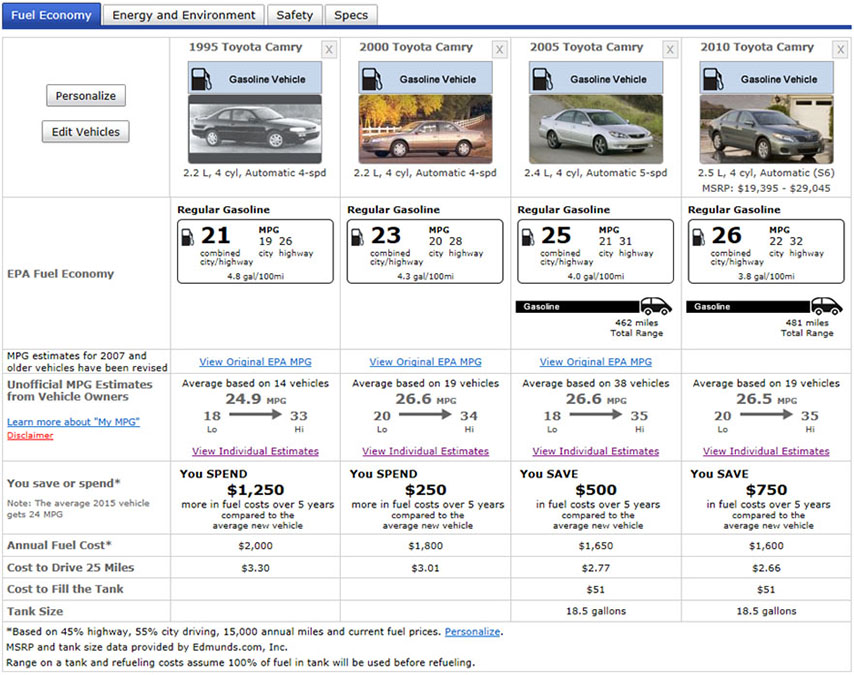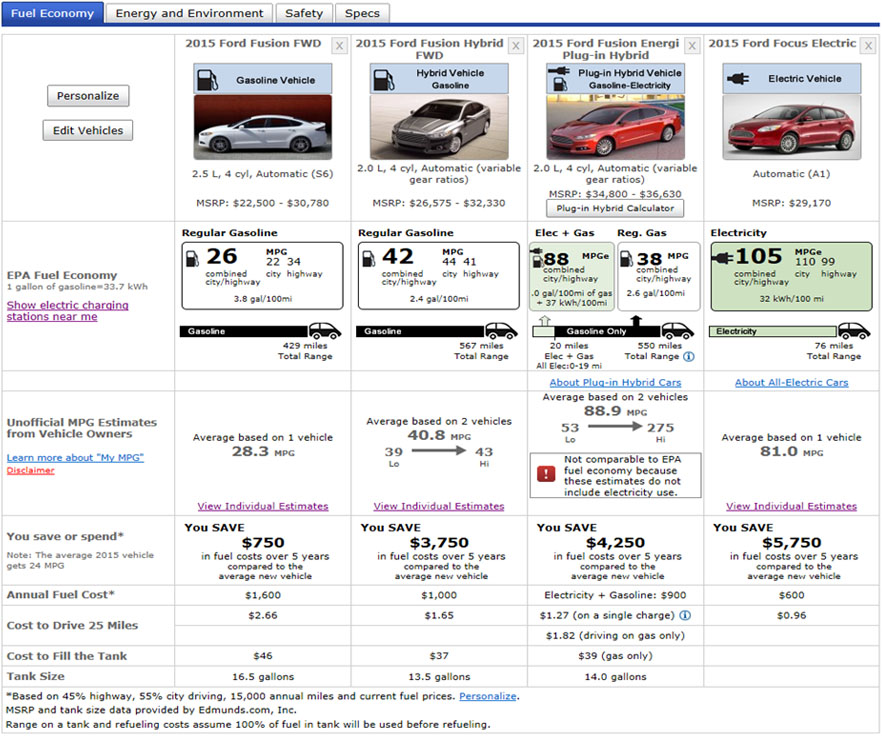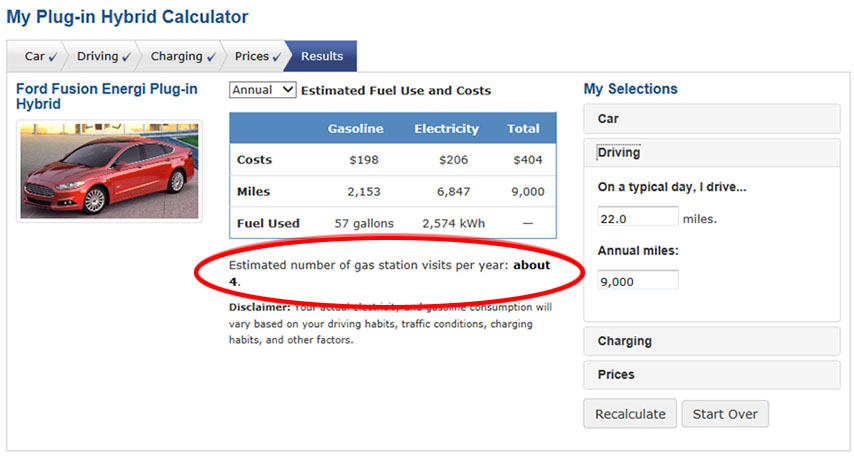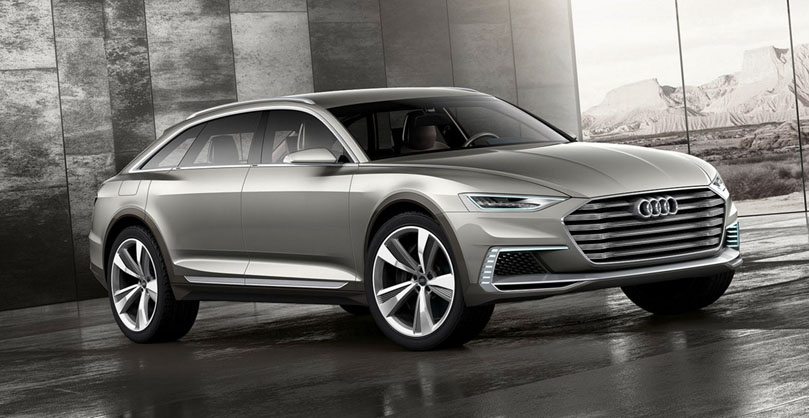What if a vehicle existed that could haul an entire family, accelerate more quickly, all while consuming roughly one-fifth the fuel of a conventional gasoline powered vehicle? It may sound like science fiction. The best of all worlds. But this may become a reality sooner than you think. In this blog, we will take a look at the line-up of plug-in hybrid electric vehicles to be launched this fall, and how they have the potential to cause a disruptive change in fuel consumption patterns.
While a regular hybrid vehicle does improve fuel economy significantly over a conventional combustion engine vehicle, the gain is mostly seen in stop-and-go city driving. In prior generations of conventional or non-plug in hybrids, the electric motor provides a boost to help acceleration and to take the load off of the main gasoline engine. This allows the car to have a smaller and more efficient gasoline engine and optimize the use of both the electric motor and the gasoline engine for maximum efficiency. Some hybrids could run on battery alone for a short distance, but it was generally not enough to make it worth adding the extra systems that are necessary to allow plugging the vehicle in to charge the batteries. A hybrid would provide an overall efficiency gain of roughly 30% over a gasoline version of a similar sized vehicle in mixed driving conditions. This sounds like a pretty good gain in efficiency, but the added cost of adding the hybrid systems to a vehicle’s price rarely paid out for anyone but the most active drivers. We have seen widespread adoption of hybrids within taxi and other automotive fleets, but this type of customer has tended to dominate over sales to the general public.
What has changed?
In recent years, battery technology has improved significantly to the point where a small battery pack can provide about 20-30 miles or about 32-50km of range on electric power alone. This might not sound like a significant distance, but for most people this is enough range to cover their daily commute and running a few errands around town. In my own situation, I live about 13km from downtown Calgary, so when I do drive in to work, I could get to work and home again with a bit of range left over to run another errand or pick up the kids from whatever activity they have on a given day. All of this would take place on battery alone, as a plug-in hybrid would be charged at home when it is not in use and the vehicle would almost always leave the house with a full charge. A driver with a daily commute and lifestyle that doesn’t exceed the range would be able to drive for weeks without the gasoline engine in the vehicle even turning on.
The obvious advantage that a plug-in hybrid has over a full electric vehicle is that when the battery does run low on charge, the car would simply switch over to the gasoline engine. The vehicle would then operate as a regular hybrid vehicle, which is already quite efficient. For longer trips and highway driving, the gasoline engine would take over when the battery is depleted and the vehicle would run on gasoline for a larger portion of the trip. It is also a potential advantage in cold weather climates where battery performance could be affected by cold conditions. While everyone’s driving habits are different, and not every trip will fall within the range of the battery, most city dwellers would likely find even 20 miles or 30km a very practical range. We have to bear in mind that we are still in the early days of this type of technology being launched. In a few years, the range of the batteries will likely increase to 60km or 80km and it will become increasingly rare that the range on the batteries would be ever be exceeded for anything other than longer road trips.
When we look at the improvements in fuel economy that have taken place in the last few decades, they have been largely incremental. The image below compares a 4 cylinder Toyota Camry with identical specs (base model/automatic transmission) from 1995 to 2010 and we see an improvement in fuel economy from 21mpg to 26mpg. Today a 2015 Camry will get about 28 mpg.

The fuel economy improvement that we will see with the introduction of plug-in hybrids is remarkable. Picking on a different automaker this time, and comparing a similar line-up of four door sedans available today we can see that Ford’s base model Fusion sedan will consume around 26mpg while the hybrid version will consume 42mpg. The plug-in version claims to go 88 mpg equivalent. This is less than one third of the fuel consumed compared to the base model and half that of the hybrid. Considering that we have seen roughly a 25% improvement in fuel economy in this type of car in the past two decades, going from 26 mpg to 88 mpg overnight has the potential to disrupt fuel consumption rates a lot more quickly.

The images and data are directly from the US government’s website – www.FuelEconomy.gov
They also have an interesting tool that allows you to calculate what you might expect to save from driving a plug-in hybrid based on your driving habits. By inputting the amount of your daily and annual driving it calculates how much you will be using battery power versus gasoline.
One interesting feature is that the calculator also spits out an estimate of the number of gas station visits that you would make in a year. I input the rough data covering my own personal driving habits and the number that the calculator generated was 4 trips per year to the gas station if I was driving a plug-in hybrid. I currently fill my vehicle about once every two weeks, so switching from a regular gasoline powered vehicle to a plug-in hybrid would drop my gas station visits from around 26 per year to 4. I find it hard to think of only going to the gas station once per quarter. I might even have to add fuel stabilizer to my gas tank to make sure that the fuel doesn’t get stale for sitting too long.

While Ford’s Fusion plug-in hybrid just looks like their regular Fusion sedan, GM and Toyota have taken the approach of developing a new segment of ‘green’ vehicles. GM’s Chevrolet Volt and the Toyota Prius are designed to look the part with a distinctive shape and definitely allows the owner to project some environmentally sensitive credibility. While this may be the image that some people want to portray in their choice of vehicle, it is not for everyone. What if you just want a sporty car or one that doesn’t make you look like a Greenpeace activist? (Not that I am taking any sides in any environmental debate or making any judgements on anyone’s particular vehicle choice here. I am merely pointing out that the owner of a Prius and the owner of a Hummer likely have differing views on certain issues.) And what if you have a large family? Or need to carry hockey equipment, bikes, strollers or other items that would quickly overwhelm the trunk space of a mid-size sedan?
Back to the title of this blog - Coming this fall, the three largest German automakers, Audi, BMW and Mercedes Benz, are launching 3 or 4 plug-in hybrid vehicles to each of their product offerings. These automakers have figured out how to incorporate this technology into their existing and most popular vehicles. Plug-in versions of Audi’s A3 and A4, BMW’s 3-series, and Mercedes C-series sedans are scheduled to come to North America this fall. This group of automakers will also release plug-in hybrid versions of their large and mid-size SUVs, which are sure to be popular in the upscale family market. While exact fuel economy statistics haven’t been released yet, the initial claims are that they will be in the 90-100mpg (or 2-2.5l/100km) range.
Using a standard gasoline powered Audi Q7 full side SUV as an example. The standard government fuel economy test on the gas powered Q7 suggests that in combined city/highway driving the vehicle will consume around 18 mpg (or 13l/100km). Their upcoming plug-in hybrid Q7 is projected to attain around over 90mpg as the tests project a large portion of the driving to take place on shorter trips using only the electric power. The stats are similar for the full size SUVs being offered by the other manufacturers. A full sized SUV that uses less fuel than any gasoline powered car on the road today?
While saving fuel is nice, there are drivers that also prefer a sporty car with quick acceleration. These automakers have turned the idea of a boring, slow hybrid vehicle on its head. Audi recently showcased a concept vehicle called the Allroad Prologue. This vehicle combines a twin-turbo V8 engine with a hybrid electric system to generate over 700hp combined and accelerates from 0-60mph (or 0-100km/h) in 3.5 seconds. This is super-car fast acceleration in the form of a so-called family station wagon.

Photo: www.Audi.com
While the addition of electric motors and batteries adds weight and complexity to the vehicle, the combination can actually improve acceleration of the vehicle overall. If you want to accelerate as quickly as possible, the combination of the electric and gasoline motors allows the low-end torque of the electric motor to work in tandem with the power of a turbo engine at higher RPMs and optimize the performance (or efficiency) of both systems. That said, the efficiency gains from a plug-in hybrid come from using only the electric motor in the city, and obviously accelerating in a much more civilized manner. But there is nothing stopping you from putting your foot down and engaging both gasoline and electric systems to their maximum ability. It does sound like fun to have the option there when you want it.
But not everyone can afford a high-end Audi, BMW or Mercedes-Benz. How do you suggest rapid adoption of this technology when only high end car buyers will be able to afford it?
On a recent trip to Los Angeles I saw an advertisement for the Ford Fusion ‘Energi’ plug-in hybrid that is available today on a 3-year lease for $266 per month. The plug-in hybrid vehicle actually qualifies for a number of government tax credits and incentives and, at this lease rate, costs about the same per month as the base gasoline model ($242 per month vs $266 per month). Based on the claimed fuel economy of the plug-in hybrid over the base model, it won’t take much driving each month for the owner to save more than the $24 per month difference in price between the two versions. A car that costs about the same as the regular version, but uses 1/3rd the amount of fuel? With this in mind it doesn’t make any sense not to lease the plug-in hybrid. And who cares if vehicle technology is far better or the batteries are starting to lose their charge capacity after 3 years? At the end of the lease, the owner could simply turn the vehicle back to the dealer and get the latest and greatest version.

While Tesla has the vision for an all-electric future, a plug-in hybrid vehicle does an effective job of bridging the gap between these worlds. While we are waiting for electric charging stations to be built out in a more significant way, this type of vehicle offers most of the fuel economy advantages of an electric vehicle and will never leave you worried that you won’t be able to make it to the next charging station. Regardless of whether the world goes to all-electric vehicles or spends some time transitioning to plug-in hybrids, we are entering a time where the possibility of consuming a fraction of the fuel that we once did will be a reality.
But where will all of the electricity come from?
Widespread adoption of this technology will likely increase electricity demand and that has to come from somewhere. As I discussed in previous blogs on this topic, North America’s electricity comes from roughly 39% coal and 28% natural gas. Will we see an increase in consumption of these fuels? It is likely.
However, Audi has one clever solution to this issue and has partnered with Sunpower, a provider of rooftop solar power systems. They sell you the plug-in hybrid car and then refer you to Sunpower for the installation of solar panels on the roof of your home. It seems like a smart plan, as the buyer of a car that runs mostly on electricity will also likely be open to the idea of putting solar panels on their roof top to generate their own electricity.
While the type of solar powered car shown below isn’t particularly practical, the combination of an electric or plug-in hybrid with a rooftop solar system could achieve roughly the same goal.

Photos (left to right): www.Wikipedia.org, www.Audi.com, www.Inhabitat.com
This material is provided for general information and is not to be construed as an offer or solicitation for the sale or purchase of securities. Neither the author or Richardson GMP Limited makes any representation or warranty, expressed or implied, in respect thereof, or takes any responsibility for any errors or omissions which may be contained herein or accepts any liability whatsoever for reliance on this report or its contents. Links to other websites or references to products, services or publications other than those of Richardson GMP Limited on this website do not imply the endorsement or approval of such websites’ products, services or publications by Richardson GMP Limited. Richardson GMP Limited makes no representations or warranties with respect to, and is not responsible or liable for, these websites’ products, services or publications.